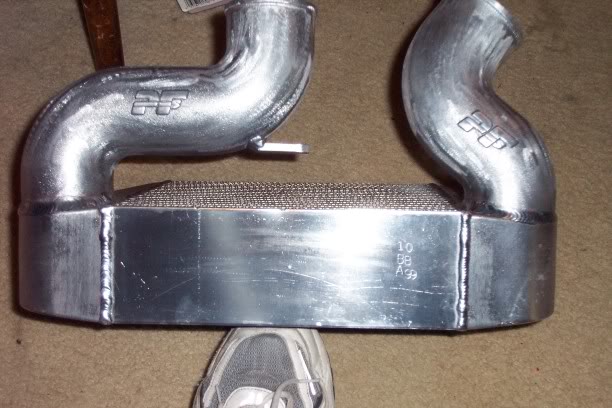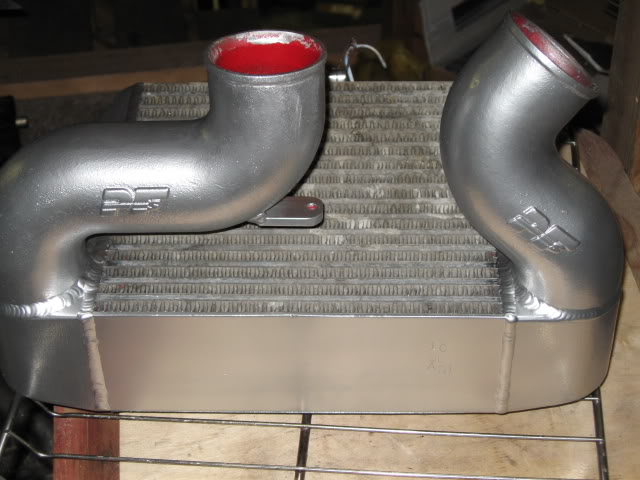Does painting the intercooler fins affect IC efficiency?
#1
Does painting the intercooler fins affect IC efficiency?
I am going to be painting many things inside my engine bay with engine enamel to make everything look as not-bling and as stock as possible. Does anyone know if painting your intercooler core adversely affect the core's efficiency? I'd imagine it does, but I believe I've seen a few people do it.
#2
What IC are you using? Couldn't you just paint the endtanks, and leave the core alone? The fins on IC cores are very thin for optimal heat transfer. I would think covering them with paint would lower their efficiency.
#3
I have a PFS intercooler, so the endtanks right now are BRIGHT red, something that Kalifornia police officers absolutely LOVE to see under your hood. I was thinking of just painting the endtanks a sort of dull silver, like I'll be painting the throttle body elbow, SR cold air box, Y-pipe and UIM. I'll also be changing from orange couplers with polished clamps to black silicone couplers to flat black clamps. Hopefully this will give the engine bay a clean, homogeneous look that will go well with the silver exterior and look stock. I was thinking of painting everything black but I'm stupid and I don't know what that would do regarding where the heat in the engine bay soaks up.
The IC core doesn't HAVE to be painted, but if it doesn't affect the performance then I'd like to do it. If it does, then I guess it's no big deal to leave it polished.
The IC core doesn't HAVE to be painted, but if it doesn't affect the performance then I'd like to do it. If it does, then I guess it's no big deal to leave it polished.
#7
paint is measured in milage.....milage is the thickness of the paint applied to a surface(millimeteres)... if u paint the fins.....u will be adding millage therefore cutting down the room for airflow/cooling......dont do it!!!!
Trending Topics
#10
You CAN paint the core FLAT BLACK. This can increase what is known as the emissivity of the surface, thus improving heat rejection capabilities vs. a bare or polished surface.
#11
Originally Posted by Speed of light
You CAN paint the core FLAT BLACK. This can increase what is known as the emissivity of the surface, thus improving heat rejection capabilities vs. a bare or polished surface.
What type of paint would you recommend/has anyone else done this with decent results?
#13
Originally Posted by Speed of light
You CAN paint the core FLAT BLACK. This can increase what is known as the emissivity of the surface, thus improving heat rejection capabilities vs. a bare or polished surface.
#14
http://www.mm-inet.com/new/844735.htm
painting the end tanks i would bet will hardly affect the efficiency of the cooling since the core is what is doing all of the work.
painting the end tanks i would bet will hardly affect the efficiency of the cooling since the core is what is doing all of the work.
#16
Originally Posted by dgeesaman
For this to work, the conductivity of the paint has to be very good. Do you know of any paints that are thin and conductive enough for this application?
#17
most radiators are not OEM aluminum when radiator painting was popular, as far as i'm concerned the bare Al surface is best for cooling but the basics of cooling are similar between radiators and intercoolers with the exception of you are cooling air not water.
i would just paint the side tanks if that is all that is anodized as as i said the bare aluminum surface would be best for the cooling transfer but radiator paint is the best alternative.
i would just paint the side tanks if that is all that is anodized as as i said the bare aluminum surface would be best for the cooling transfer but radiator paint is the best alternative.
#18
I'll go against the rest. Painting it won't affect it for you to even notice. We're probably talking .001% effeciency difference. Just make sure you don't clog the fins or put a gazillion coats on it. You should be fine painting it. Black looks good and has a nice sleeper look.
#19
I would be very surprised if painting the core *didn't* have a significant effect on the efficiency. Particularly for a dense core, painting it would likely drop the efficiency substantially, as many air paths would be blocked by the paint. Painting an intercooler core is a bit like pissing on flowers -- it defeats the purpose of buying them in the first place.
However, the thin "radiator paint" stuff would probably be fine for all but the highest density cores, since it goes on thin.
Annodizing might be very expensive, since there is so much surface area.
Just paint or strip the end tanks.
-Max
However, the thin "radiator paint" stuff would probably be fine for all but the highest density cores, since it goes on thin.
Annodizing might be very expensive, since there is so much surface area.
Just paint or strip the end tanks.
-Max
#22
Yes it's twin turbo...
iTrader: (4)
Joined: Jun 2005
Posts: 1,487
Likes: 0
From: Vacaville, California
dug a little info up...
"Can an intercooler be painted?
Certainly. One might find a small loss of efficiency if the core is painted, but likely this would be less of a difference than the repeatability of measurement. By all means, paint the end tanks, but preference suggests the core remain exposed." -bell intercoolers.com
"...aluminum MAF pipe, aluminum inlets pipe, relocate your MAT sensor, frontmount intercooler. The aluminum helps remove heat from the intake air, thatís important to remember. Youíre heating the air after the turbo by compressing it and this pathway should NOT be wrapped or coated in any way. For efficiency, we like to keep the total intake system, that carries only air, all aluminum. If you paint an intercooler face to camouflage it, be light with the coat. Do not powdercoat or ceramic coat the intercooler or pipes. (Coating the pipes will yield the opposite results and retain heat within the pipes.)" - ESPPerformance.com/techtips
"Can I paint my intercooler black?
Yes. We prefer to coat an intercooler black, for improved heat dissipation. It is known that black effectively radiates heat better than a polished surface. Having a black intercooler core only increases its efficiency. The reason behind leaving an intercooler unpainted is only for aesthetics" - http://www.cypherindustries.com.au/t...ical.php#cool4
"Can an intercooler be painted?
Certainly. One might find a small loss of efficiency if the core is painted, but likely this would be less of a difference than the repeatability of measurement. By all means, paint the end tanks, but preference suggests the core remain exposed." -bell intercoolers.com
"...aluminum MAF pipe, aluminum inlets pipe, relocate your MAT sensor, frontmount intercooler. The aluminum helps remove heat from the intake air, thatís important to remember. Youíre heating the air after the turbo by compressing it and this pathway should NOT be wrapped or coated in any way. For efficiency, we like to keep the total intake system, that carries only air, all aluminum. If you paint an intercooler face to camouflage it, be light with the coat. Do not powdercoat or ceramic coat the intercooler or pipes. (Coating the pipes will yield the opposite results and retain heat within the pipes.)" - ESPPerformance.com/techtips
"Can I paint my intercooler black?
Yes. We prefer to coat an intercooler black, for improved heat dissipation. It is known that black effectively radiates heat better than a polished surface. Having a black intercooler core only increases its efficiency. The reason behind leaving an intercooler unpainted is only for aesthetics" - http://www.cypherindustries.com.au/t...ical.php#cool4
#23
from what u quoted ^
one says bare metal is better for heat dissapation, the other claims that flat black paint is better than a polished surface.
hm what about painted vs. bare unpolished metal?
one says bare metal is better for heat dissapation, the other claims that flat black paint is better than a polished surface.
hm what about painted vs. bare unpolished metal?
#24
That would require testing. Heat is transferred in 2 ways: conductive and radiant heat transfer. Conductive transfer is from things that are touching, so the conduction would be air-aluminum-air would now be air-aluminum-paint-air. Just like resistance in an electrical circuit, the paint will reduce the heat transfer, and how much depends on how thick the paint is and how conductive it is. Ditto for anodization, although I believe in anodization the aluminum oxide layer (which is present on all bare aluminum) may be removed first, which is an advantage over paint. A dark finish that removes the aluminum oxide may in fact be superior in conduction.
Radiant transfer depends on the color of the objects, and black is better than the silverish bare aluminum. I question that idea though - radiant transfer would basically move heat from the core to the next solid object - not the air. So increasing radiant heat transfer would warm the surrounding engine components, which would keep slightly more heat in the engine bay.
So intercooler paint would have to create enough radiant heat transfer to offset the loss in conductive heat transfer - and only an experiment will answer that question. My gut instinct tells me that conductive/convective flow dominates over the radiant in this situation, but opinions are cheap in value.
And in the automotive world, the best experimenters are racers. I think the best answer, if there is a significant advantage either way, would come from someone with hands-on experience.
Dave
Radiant transfer depends on the color of the objects, and black is better than the silverish bare aluminum. I question that idea though - radiant transfer would basically move heat from the core to the next solid object - not the air. So increasing radiant heat transfer would warm the surrounding engine components, which would keep slightly more heat in the engine bay.
So intercooler paint would have to create enough radiant heat transfer to offset the loss in conductive heat transfer - and only an experiment will answer that question. My gut instinct tells me that conductive/convective flow dominates over the radiant in this situation, but opinions are cheap in value.
And in the automotive world, the best experimenters are racers. I think the best answer, if there is a significant advantage either way, would come from someone with hands-on experience.
Dave
#25
I doubt that spraying the front of the core with a thin coat would have any effect. The cooling (heat exchange) occurs inside the core and not on the very front edges of the thing. As long as you do not plug the airflow holes you won't change much.




